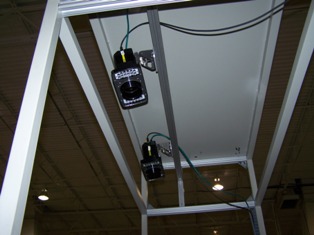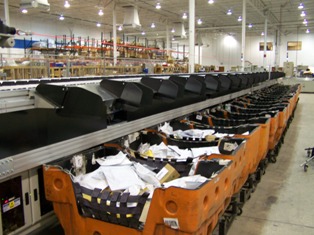The parcel (and flats) delivery landscape is undergoing major changes. Online retailers, fulfillment houses, direct marketers, and others that utilize the USPS for last-mile delivery of low-weight articles are prime candidates for sorting systems that are ergonomically flexible, operationally efficient, and offer an aggressive return on investment.
Companies having large-scale sorting operations use sorting systems that are much too large and expensive to cost-effectively meet these requirements. For example, the facility for one major company occupies over 4 million square feet and contains more than 17,000 feet of conveyor. This is not an effective solution for the delivery of low-weight articles. At the other end of the spectrum, many companies currently processing low-weight parcels and flats are manually sorting, which due to costs, is no solution at all.
Consequently, companies seeking to enter this lucrative market and companies currently in the market need low-weight parcel and flats sorting systems tailored and priced to meet their needs.

Looking at scanning technology
A critical aspect of a parcel sorting system is the reading of the barcode on a package or flat as it travels down the line at high speeds. The wide variation in the shapes and sizes of these items present a challenge that requires a vision system able to maintain high read rates at constantly changing focal lengths. In addition, many items are shipped in flexible plastic or poly-wrap envelopes that take on the shape of the contents. This distorts the barcode on the envelope making it hard for a vision system to read.
Today's sorting systems normally use line scan vision cameras. A line-scan camera has a single row of pixel sensors that capture image frames as the article moves past the camera. These image frames are continuously fed to software that joins them to each other to make a complete image.
With image-based technology there are really four steps to reading a barcode: take an image of the article, find the barcode in the image, generate a signal, and decode it. Major improvements have been made in the signal generation and decode phase. New signal generation technology makes decoding better and faster. It improves the signal quality and drastically increases the speed of signal acquisition. This approach is around 20x faster than the other signal generation methodologies. It provides exceptionally high read rates on 1-D barcodes, including those that are damaged, distorted, blurred, scratched, low height or low contrast. Just as important, the ability to extract many more 1-D signals every millisecond is used to eliminate decoding shortcuts, thereby reducing failure modes and improving read rates.

The end result is read rates in the high 90's. These read rates are substantially higher than line scan readers for the challenging mix of package types and sizes that the new sorter is designed to handle. In the past, tests have shown that line scan systems outperformed area scan systems by offering higher read rates across the board. But the new technology has produced for the first time an area scan system capable of outperforming the best line scan technology while maintaining the traditional benefits of area scan technology such as compact size, low cost, and ease of integration. As a result, parcel sorting systems manufacturers are transitioning sorting systems from line scan to area scan technology. The new vision systems are quite simple to setup and configure for the IMB postal barcodes used in the initial configuration.
About the author: Shane LaChappelle joined Cognex Corporation (Natick, MA;http://www.cognex.com/) in 2010 and now serves as the company's Product Marketing Manager for Logistics Systems where his focus is on developing a strategy for Tire ID, evolving Logistics Systems market strategies, and identifying next-generation product needs. With more than 10 years of industry experience in related fields of Engineering, Sales and Product Management, LaChappelle spent the last two years in Product Marketing on the Strategic Market Development team in the ID Business Unit at Cognex Corp. He earned a Bachelor of Science degree in Engineering, Mechanical from Western Michigan University in 2004 and is currently completing his MBA from Babson College.
Companies having large-scale sorting operations use sorting systems that are much too large and expensive to cost-effectively meet these requirements. For example, the facility for one major company occupies over 4 million square feet and contains more than 17,000 feet of conveyor. This is not an effective solution for the delivery of low-weight articles. At the other end of the spectrum, many companies currently processing low-weight parcels and flats are manually sorting, which due to costs, is no solution at all.
Consequently, companies seeking to enter this lucrative market and companies currently in the market need low-weight parcel and flats sorting systems tailored and priced to meet their needs.

Looking at scanning technology
A critical aspect of a parcel sorting system is the reading of the barcode on a package or flat as it travels down the line at high speeds. The wide variation in the shapes and sizes of these items present a challenge that requires a vision system able to maintain high read rates at constantly changing focal lengths. In addition, many items are shipped in flexible plastic or poly-wrap envelopes that take on the shape of the contents. This distorts the barcode on the envelope making it hard for a vision system to read.
Today's sorting systems normally use line scan vision cameras. A line-scan camera has a single row of pixel sensors that capture image frames as the article moves past the camera. These image frames are continuously fed to software that joins them to each other to make a complete image.
With image-based technology there are really four steps to reading a barcode: take an image of the article, find the barcode in the image, generate a signal, and decode it. Major improvements have been made in the signal generation and decode phase. New signal generation technology makes decoding better and faster. It improves the signal quality and drastically increases the speed of signal acquisition. This approach is around 20x faster than the other signal generation methodologies. It provides exceptionally high read rates on 1-D barcodes, including those that are damaged, distorted, blurred, scratched, low height or low contrast. Just as important, the ability to extract many more 1-D signals every millisecond is used to eliminate decoding shortcuts, thereby reducing failure modes and improving read rates.

The end result is read rates in the high 90's. These read rates are substantially higher than line scan readers for the challenging mix of package types and sizes that the new sorter is designed to handle. In the past, tests have shown that line scan systems outperformed area scan systems by offering higher read rates across the board. But the new technology has produced for the first time an area scan system capable of outperforming the best line scan technology while maintaining the traditional benefits of area scan technology such as compact size, low cost, and ease of integration. As a result, parcel sorting systems manufacturers are transitioning sorting systems from line scan to area scan technology. The new vision systems are quite simple to setup and configure for the IMB postal barcodes used in the initial configuration.
About the author: Shane LaChappelle joined Cognex Corporation (Natick, MA;http://www.cognex.com/) in 2010 and now serves as the company's Product Marketing Manager for Logistics Systems where his focus is on developing a strategy for Tire ID, evolving Logistics Systems market strategies, and identifying next-generation product needs. With more than 10 years of industry experience in related fields of Engineering, Sales and Product Management, LaChappelle spent the last two years in Product Marketing on the Strategic Market Development team in the ID Business Unit at Cognex Corp. He earned a Bachelor of Science degree in Engineering, Mechanical from Western Michigan University in 2004 and is currently completing his MBA from Babson College.





